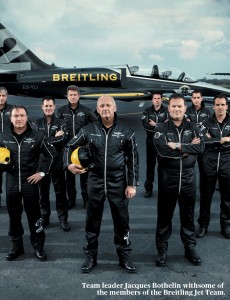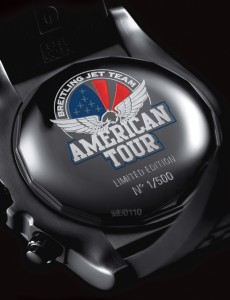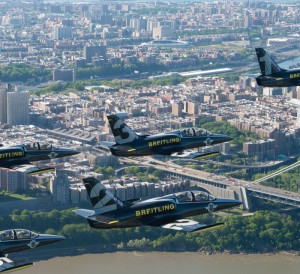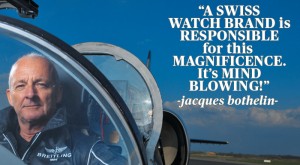Breitling USA president Thierry Prissert removed a striking black steel chronograph from his wrist and handed it across the tabletop. I smiled as I held it in my hands, not simply because of the satisfying weight and solidity of the copy Breitling watches or its unique motif.
To my right and left, up and down the long dining table were identical examples wrapped around the wrists of the men this special timepiece pays tribute to — the pilots of the Breitling Jet Team (BJT). In several hours I’d know the significance behind its black and yellow dial intimately. The next morning I’d be airborne, in tight formation with the BJT, the world’s largest and most professional civilian jet display team.

American Tour
Turning the chronograph over revealed the reason for our rendezvous with the team. Emblazoned on the caseback is a logo – a circle in red, white and blue bounded by the seven jets of the BJT in the upper left, red stripes in the upper right and white wings on its lower half buttressed by the words “American Tour.”
A common sight at airshows across Europe annually, the Breitling Jet Team has also toured Asia and Russia. This year, the team spent the spring and summer flying over American cities and air bases for the first time. The limited edition (500 pieces) Breitling Jet Team American Tour Chronomat 44 Blacksteel is the timekeeping emblem of the historic occasion.
 I was on hand for the debut stop on the American tour in April at the SUN’nFUN International Fly-In and Expo in Lakeland, Florida, just east of Tampa. One of the largest aviation events in the nation, the annual airshow has served as a kick-off for the domestic air show season since 1974 and it was the stage for the long-awaited public debut of the Breitling Jet Team.
I was on hand for the debut stop on the American tour in April at the SUN’nFUN International Fly-In and Expo in Lakeland, Florida, just east of Tampa. One of the largest aviation events in the nation, the annual airshow has served as a kick-off for the domestic air show season since 1974 and it was the stage for the long-awaited public debut of the Breitling Jet Team.
Breitling’s U.S.A. Aviation Consultant Jim DiMatteo and the team spent more than year pulling off this aviation coup. With the full support of Breitling, he and the team pioneered a reciprocity agreement between the FAA and other countries to allow the BJT and other foreign pilots flying foreign-registered aircraft to perform in American airspace. This long-desired framework is a major step forward for sport aviation and the international airshow industry.
I watched from the flight line as the BJT flew its first performance over fake Breitling watches American soil and was on hand as the team’s seven L-39C Albatrosses taxied in after landing.
At 9 a.m. the following morning I joined several others also preparing to fly with the Team. We donned black flight suits decorated with “Breitling Jet Team” across the back. Three-quarters of an hour later, after a helmet fitting and a preflight briefing, I climbed into the rear cockpit of BJT Number 5 and strapped into the ejection seat.
Up front, pilot Georges-Eric Castaing – call sign “Georgio” – went through the engine-start procedure for the L-39 with us. Capable of 405 knots (466 mph) in level flight and stressed for +8/-4 Gs, the Albatross is a product of the Cold War – a jet trainer developed in Czechoslovakia in the late 1960s by Czech aerospace firm Aero Vodochody. Generations of Russian and Soviet-Bloc pilots underwent advanced training in the L-39C before graduating to fighters including the MiG-29, SU-27 and other tactical jets.
 Minutes later, we lined up on runway 9/27 with Number 3 piloted by Christophe Deketelaere on our left and the other five BJT Albatrosses directly ahead. Leader Jacques Bothelin gave the command to take off and the group began accelerating in three elements.
Minutes later, we lined up on runway 9/27 with Number 3 piloted by Christophe Deketelaere on our left and the other five BJT Albatrosses directly ahead. Leader Jacques Bothelin gave the command to take off and the group began accelerating in three elements.
Georgio pulled the nose up as we passed through 120 knots and to our left, Deketelaere rotated simultaneously. In less than two seconds our element lifted off. Gear up, flaps-up, we began a shallow climb, accelerating toward the aircraft just a couple hundred yards ahead.
In a few more seconds the rest of the BJT was literally just above our canopy, feet away. The letters Copy Breitling Cockpit watches UK came into brilliant focus on the undersides of the L-39s’ fuselage as we slid into the second slot position at the right rear of the formation.It was an absolutely gorgeous sight.
Six thousand feet above the beautiful central Florida highlands, we headed southeast toward a maneuvering area. During the transit, Georgio and I talked flying and I had a moment to reflect.
I’ve been fortunate over my career to do some very fun, very dynamic flying in military and civilian aircraft. I’ve flown formation before, but nothing like this. It’s magic and, incredibly, I’m not experiencing it with a military display team.
The BJT is the world’s largest, most professional civilian jet aerobatic team – and it operates under corporate agency, not a military structure. This isn’t the Blue Angels, the Thunderbirds or even the Patrouille Suisse.

3 Gs, 360 Degrees
Having reached the maneuvering area, the pilots adjust their position in the formation and we accelerate in a left bank.
Georgio cues the mic, “Now we pull… 3 Gs!”
The formation rotates as one into our first maneuver – a smooth, arcing barrel roll. Moderate G-forces drive my own tail end firmly into the ejection seat as the horizon tilts to the right then spins inverted, continuing through 360 degrees as the L-39s all around us maintain position.
We roll out straight and level briefly then climb slightly before all seven jets point their noses toward the earth. Team leader Bothelin is flying the formation downhill to gather speed for the next maneuver, a big graceful formation loop.
We accelerate toward 400 knots and bottom out.
“Up we go and… pull!” says Georgio.
The stick comes back into my lap, the G forces hit harder (my brain/G-sensor tells me it’s close to a 4G pull up) and there’s a bit of buffet on the way up. The jets pull vertical as one, and as we go over the top it occurs to me that, apropos of this cheap replica Breitling-sponsored team, executing a loop is like the sweep of a seconds hand.
